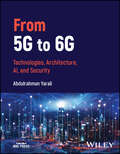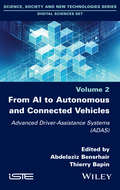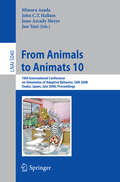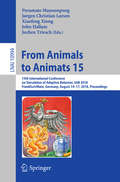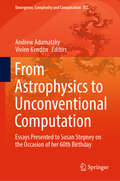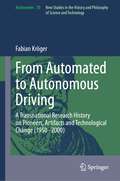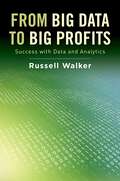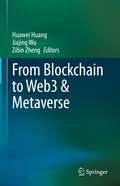- Table View
- List View
From 5G to 6G: Technologies, Architecture, AI, and Security
by Abdulrahman YaraliFrom 5G to 6G Understand the transition to the sixth generation of wireless with this bold introduction The transition from the fifth generation of wireless communication (5G) to the coming sixth generation (6G) promises to be one of the most significant phases in the history of telecommunications. The technological, social, and logistical challenges promise to be significant, and meeting these challenges will determine the future of wireless communication. Experts and professionals across dozens of fields and industries are beginning to reckon seriously with these challenges as the 6G revolution approaches. From 5G to 6G provides an overview of this transition, offering a snapshot of a moment in which 5G is establishing itself and 6G draws ever nearer. It focuses on recent advances in wireless technology that brings 6G closer to reality, as well as the near-term challenges that still have to be met for this transition to succeed. The result is an essential book for anyone wishing to understand the future of wireless telecommunications in an increasingly connected world. From 5G to 6G readers will also find: 6G applications to both AI and Machine Learning, technologies which loom ever larger in wireless communication Discussion of subjects including smart healthcare, cybersecurity, extended reality, and more Treatment of the ongoing infrastructural and technological requirements for 6G From 5G to 6G is essential for researchers and academics in wireless communication and computer science, as well as for undergraduates in related subjects and professionals in wireless-adjacent fields.
From 5G to 6G: Technologies, Architecture, AI, and Security
by Abdulrahman YaraliFrom 5G to 6G Understand the transition to the sixth generation of wireless with this bold introduction The transition from the fifth generation of wireless communication (5G) to the coming sixth generation (6G) promises to be one of the most significant phases in the history of telecommunications. The technological, social, and logistical challenges promise to be significant, and meeting these challenges will determine the future of wireless communication. Experts and professionals across dozens of fields and industries are beginning to reckon seriously with these challenges as the 6G revolution approaches. From 5G to 6G provides an overview of this transition, offering a snapshot of a moment in which 5G is establishing itself and 6G draws ever nearer. It focuses on recent advances in wireless technology that brings 6G closer to reality, as well as the near-term challenges that still have to be met for this transition to succeed. The result is an essential book for anyone wishing to understand the future of wireless telecommunications in an increasingly connected world. From 5G to 6G readers will also find: 6G applications to both AI and Machine Learning, technologies which loom ever larger in wireless communication Discussion of subjects including smart healthcare, cybersecurity, extended reality, and more Treatment of the ongoing infrastructural and technological requirements for 6G From 5G to 6G is essential for researchers and academics in wireless communication and computer science, as well as for undergraduates in related subjects and professionals in wireless-adjacent fields.
From Access to SQL Server
by Russell SinclairThis book covers what Access developers need to know about SQL Server, covering the two most common versions of both products: Microsoft Access 97 and 2000 and Microsoft SQL Server 6.5 and 7. The author offers his own tips and techniques based on practical hands-on experience. The resulting book teaches developers how to accomplish their goal without over-simplifying the migration process. Further, it includes detailed information on how to work with SQL Server outside of the Access environment and how to design efficient SQL Server databases. It outlines the planning involved and helps developers make educated decisions along the way.
From Action Systems to Distributed Systems: The Refinement Approach
by Luigia Petre Emil SekerinskiFormal methods traditionally address the question of transforming software engineering into a mature engineering discipline. This essentially refers to trusting that the software-intensive systems that form our society's infrastructures are behaving according to their specifications. More recently, formal methods are also used to understand propert
From Active Data Management to Event-Based Systems and More: Papers in Honor of Alejandro Buchmann on the Occasion of His 60th Birthday (Lecture Notes in Computer Science #6462)
by Kai Sachs Ilia Petrov Pablo GuerreroData management has evolved over the years from being strictly associated with database systems, through active databases, to become a topic that has grown beyond the scope of a single field encompassing a large range of subjects, such as distributed systems, event-driven systems, and peer-to-peer and streaming systems. The present collection of works, which sheds light on various facets of data management, is dedicated to Prof. Alejandro Buchmann on the occasion of his 60th birthday. His scientific path looks back on more than thirty years of successful academic life and high-impact research. With this book we celebrate Prof. Buchmann's vision and achievements.
From AI to Autonomous and Connected Vehicles: Advanced Driver-Assistance Systems (ADAS)
by Abdelaziz Bensrhair Thierry BapinThe main topic of this book is the recent development of on-board advanced driver-assistance systems (ADAS), which we can already tell will eventually contribute to the autonomous and connected vehicles of tomorrow.With the development of automated mobility, it becomes necessary to design a series of modules which, from the data produced by on-board or remote information sources, will enable the construction of a completely automated driving system. These modules are perception, decision and action. State-of-the-art AI techniques and their potential applications in the field of autonomous vehicles are described.Perception systems, focusing on visual sensors, the decision module and the prototyping, testing and evaluation of ADAS systems are all presented for effective implementation on autonomous and connected vehicles.This book also addresses cooperative systems, such as pedestrian detection, as well as the legal issues in the use of autonomous vehicles in open environments.
From AI to Autonomous and Connected Vehicles: Advanced Driver-Assistance Systems (ADAS)
by Abdelaziz Bensrhair Thierry BapinThe main topic of this book is the recent development of on-board advanced driver-assistance systems (ADAS), which we can already tell will eventually contribute to the autonomous and connected vehicles of tomorrow.With the development of automated mobility, it becomes necessary to design a series of modules which, from the data produced by on-board or remote information sources, will enable the construction of a completely automated driving system. These modules are perception, decision and action. State-of-the-art AI techniques and their potential applications in the field of autonomous vehicles are described.Perception systems, focusing on visual sensors, the decision module and the prototyping, testing and evaluation of ADAS systems are all presented for effective implementation on autonomous and connected vehicles.This book also addresses cooperative systems, such as pedestrian detection, as well as the legal issues in the use of autonomous vehicles in open environments.
From Animals to Animats 10: 10th International Conference on Simulation of Adaptive Behavior, SAB 2008, Osaka, Japan, July 7-12, 2008, Proceedings (Lecture Notes in Computer Science #5040)
by Minoru Asada John C. T. Hallam Jean-Arcady Meyer Jun TaniThis book constitutes the refereed proceedings of the 10th International Conference on Simulation of Adaptive Behavior, SAB 2008, held in Osaka, Japan in July 2008. The 30 revised full papers and 21 revised poster papers presented were carefully reviewed and selected from 110 submissions. The papers are organized in topical sections on the animat approach to adaptive behaviour, evolution, navigation and internal world models, perception and control, learning and adaptation, cognition, emotion and behaviour, collective and social behaviours, adaptive behaviour in language and communication, and applied adaptive behaviour.
From Animals to Animats 11: 11th International Conference on Simulation of Adaptive Behavior, SAB 2010, Paris - Clos Lucé, France, August 25-28, 2010. Proceedings (Lecture Notes in Computer Science #6226)
by Stephane Doncieux Benoît Girard Agnes Guillot John Hallam Jean-Arcady Meyer Jean-Baptiste MouretFrom Animals to Animats 12: 12th International Conference on Simulation of Adaptive Behavior, SAB 2012, Odense, Denmark, August 27-30, 2012, Proceedings (Lecture Notes in Computer Science #7426)
by Tom Ziemke Christian Balkenius John HallamThis book constitutes the proceedings of the 12th International Conference on Simulation of Adaptive Behaviour, SAB 2012, held in Odense, Denmark, in August 2012. The 22 full papers as well as 22 poster papers included in this volume were carefully reviewed and selected from 66 submissions. They are organized in topical sections named: animat approach and methodology; perception and motor control; evolution; learning and adaptation, and collective and social behaviour.
From Animals to Animats 13: 13th International Conference on Simulation of Adaptive Behavior, SAB 2014, Castellón, Spain, July 22-25, 2014, Proceedings (Lecture Notes in Computer Science #8575)
by Angel P. Del Pobil Eris Chinellato Ester Martínez-Martín John Hallam Enric Cervera Antonio MoralesThis book constitutes the proceedings of the 13th International Conference on Simulation of Adaptive Behavior, SAB 2014, held in Castellón, Spain, in July 2014. The 32 papers presented in this volume were carefully reviewed and selected for inclusion in the proceedings. They cover the main areas in animat research, including the animat approach and methodology, perception and motor control, navigation and internal world models, learning and adaptation, evolution and collective and social behavior.
From Animals to Animats 14: 14th International Conference on Simulation of Adaptive Behavior, SAB 2016, Aberystwyth, UK, August 23-26, 2016, Proceedings (Lecture Notes in Computer Science #9825)
by Elio Tuci Alexandros Giagkos Myra Wilson John HallamThis book constitutes the proceedings of the 14th International Conference on Simulation of Adaptive Behavior, SAB 2016, held in Aberystwyth, UK, in August 2016.The 31 papers presented in this volume were carefully reviewed and selected from 45 submissions. They cover the main areas in animat research, including the animat approach and methodology, perception and motor control, learning and adaptation, evolution, and collective and social behavior.
From Animals to Animats 15: 15th International Conference on Simulation of Adaptive Behavior, SAB 2018, Frankfurt/Main, Germany, August 14-17, 2018, Proceedings (Lecture Notes in Computer Science #10994)
by Poramate Manoonpong Jørgen Christian Larsen Xiaofeng Xiong John Hallam Jochen TrieschThis book constitutes the refereed proceedings of the 15th International Conference on Simulation of Adaptive Behavior, SAB 2018, held in Frankfurt/Main, Germany, in August 2018.The 21 papers presented were carefully reviewed and selected from 39 submissions. They cover the main areas in animat research, including the animat approach and methodology, perception and motor control, action selection and navigation, learning and adaptation, and collective and social behavior.
From Animals to Animats 16: 16th International Conference on Simulation of Adaptive Behavior, SAB 2022, Cergy-Pontoise, France, September 20–23, 2022, Proceedings (Lecture Notes in Computer Science #13499)
by Lola Cañamero Philippe Gaussier Myra Wilson Sofiane Boucenna Nicolas CuperlierThis book constitutes the refereed proceedings of the 16th International Conference on Simulation of Adaptive Behavior, SAB 2022, held in Cergy-Pontoise, France, in September 2022.The 17 papers presented in this volume were carefully reviewed and selected from 23 submissions. They were organized in topical sections as follows: Embodiment; Brain-Inspired Control, Adaptation, and Learning; Bio-inspired Vision and navigation; Affective and Social Cognition and Collective Intelligence.
From Animals to Animats 9: 9th International Conference on Simulation of Adaptive Behavior, SAB 2006, Rome, Italy, September 25-29, 2006, Proceedings (Lecture Notes in Computer Science #4095)
by Stefano Nolfi Gianluca Baldassare Raffaele Calabretta John Hallam Davide Marocco Orazio Miglino Jean-Arcady Meyer Domenico ParisiThis book constitutes the refereed proceedings of the 9th International Conference on Simulation of Adaptive Behavior, SAB 2006. The 35 revised full papers and 35 revised poster papers presented are organized in topical sections on the animat approach to adaptive behaviour, perception and motor control, action selection and behavioral sequences, navigation and internal world models, learning and adaptation, evolution, collective and social behaviours, applied adaptive behavior and more.
From Animals to Robots and Back: A Collection in Honour of Aaron Sloman (Cognitive Systems Monographs #22)
by Jeremy L. Wyatt Dean D. Petters David C. HoggCognitive Science is a discipline that brings together research in natural and artificial systems and this is clearly reflected in the diverse contributions to From Animals to Robots and Back.In tribute to Aaron Sloman and his pioneering work in Cognitive Science and Artificial Intelligence, the editors have collected a unique collection of cross-disciplinary papers that include work on:· intelligent robotics;· philosophy of cognitive science;· emotional research· computational vision;· comparative psychology; and· human-computer interaction.Key themes such as the importance of taking an architectural view in approaching cognition, run through the text. Drawing on the expertize of leading international researchers, contemporary debates in the study of natural and artificial cognition are addressed from complementary and contrasting perspectives with key issues being outlined at various levels of abstraction.From Animals to Robots and Back, will give readers with backgrounds in the study of both natural and artificial cognition an important window on the state of the art in cognitive systems research.
From Astrophysics to Unconventional Computation: Essays Presented to Susan Stepney on the Occasion of her 60th Birthday (Emergence, Complexity and Computation #35)
by Andrew Adamatzky Vivien KendonThis Festschrift is a tribute to Susan Stepney’s ideas and achievements in the areas of computer science, formal specifications and proofs, complex systems, unconventional computing, artificial chemistry, and artificial life. All chapters were written by internationally recognised leaders in computer science, physics, mathematics, and engineering. The book shares fascinating ideas, algorithms and implementations related to the formal specification of programming languages and applications, behavioural inheritance, modelling and analysis of complex systems, parallel computing and non-universality, growing cities, artificial life, evolving artificial neural networks, and unconventional computing. Accordingly, it offers an insightful and enjoyable work for readers from all walks of life, from undergraduate students to university professors, from mathematicians, computers scientists and engineers to physicists, chemists and biologists.
From Atom Optics to Quantum Simulation: Interacting Bosons and Fermions in Three-Dimensional Optical Lattice Potentials (Springer Theses)
by Sebastian WillThis thesis explores ultracold quantum gases of bosonic and fermionic atoms in optical lattices. The highly controllable experimental setting discussed in this work, has opened the door to new insights into static and dynamical properties of ultracold quantum matter. One of the highlights reported here is the development and application of a novel time-resolved spectroscopy technique for quantum many-body systems. By following the dynamical evolution of a many-body system after a quantum quench, the author shows how the important energy scales of the underlying Hamiltonian can be measured with high precision. This achievement, its application, and many other exciting results make this thesis of interest to a broad audience ranging from quantum optics to condensed matter physics. A lucid style of writing accompanied by a series of excellent figures make the work accessible to readers outside the rapidly growing research field of ultracold atoms.
From Automated to Autonomous Driving: A Transnational Research History on Pioneers, Artifacts and Technological Change (1950-2000) (Archimedes #70)
by Fabian KrögerThis book presents the most important milestones of the research on automated and autonomous driving in the United States, Japan and Europe throughout five decades (1950-2000). Drawing on sources from the automotive industry, electrical engineering, the robotics and AI-domain and military institutions, it retraces the transition from the guidance-cable approach to vehicle-based sensor and vision systems. Giving a detailed overview of the technical concepts, artefacts, research vehicles and robots, the book presents the transnational engineering efforts that started long before Silicon Valley entered the field. In addition, the book also uniquely details the role of the military in the domain of vehicle automation. This all ensures the book is of great interest to historians of technology, practitioners in engineering disciplines, scholars working in mobility studies, journalists, and political decision makers.
From Big Data to Big Profits: Success with Data and Analytics
by Russell WalkerTechnological advancements in computing have changed how data is leveraged by businesses to develop, grow, and innovate. In recent years, leading analytical companies have begun to realize the value in their vast holdings of customer data and have found ways to leverage this untapped potential. Now, more firms are following suit and looking to monetize Big Data for big profits. Such changes will have implications for both businesses and consumers in the coming years. In From Big Data to Big Profits, Russell Walker investigates the use of Big Data to stimulate innovations in operational effectiveness and business growth. Walker examines the nature of Big Data and how businesses can use it to create new monetization opportunities. Using case studies of Apple, Netflix, Google, LinkedIn, Zillow, Amazon, and other leaders in the use of Big Data, Walker explores how digital platforms such as mobile apps and social networks are changing the nature of customer interactions and the way Big Data is created and used by companies. Such changes, as Walker points out, will require careful consideration of legal and unspoken business practices as they affect consumer privacy. Companies looking to develop a Big Data strategy will find great value in the SIGMA framework, which he has developed to assess companies for Big Data readiness and provide direction on the steps necessary to get the most from Big Data. Rigorous and meticulous, From Big Data to Big Profits is a valuable resource for students, researchers, and professionals with an interest in Big Data, digital platforms, and analytics
From Big Data to Big Profits: Success with Data and Analytics
by Russell WalkerTechnological advancements in computing have changed how data is leveraged by businesses to develop, grow, and innovate. In recent years, leading analytical companies have begun to realize the value in their vast holdings of customer data and have found ways to leverage this untapped potential. Now, more firms are following suit and looking to monetize Big Data for big profits. Such changes will have implications for both businesses and consumers in the coming years. In From Big Data to Big Profits, Russell Walker investigates the use of Big Data to stimulate innovations in operational effectiveness and business growth. Walker examines the nature of Big Data and how businesses can use it to create new monetization opportunities. Using case studies of Apple, Netflix, Google, LinkedIn, Zillow, Amazon, and other leaders in the use of Big Data, Walker explores how digital platforms such as mobile apps and social networks are changing the nature of customer interactions and the way Big Data is created and used by companies. Such changes, as Walker points out, will require careful consideration of legal and unspoken business practices as they affect consumer privacy. Companies looking to develop a Big Data strategy will find great value in the SIGMA framework, which he has developed to assess companies for Big Data readiness and provide direction on the steps necessary to get the most from Big Data. Rigorous and meticulous, From Big Data to Big Profits is a valuable resource for students, researchers, and professionals with an interest in Big Data, digital platforms, and analytics
From Big Data to Smart Data
by Fernando IafrateA pragmatic approach to Big Data by taking the reader on a journey between Big Data (what it is) and the Smart Data (what it is for). Today’s decision making can be reached via information (related to the data), knowledge (related to people and processes), and timing (the capacity to decide, act and react at the right time). The huge increase in volume of data traffic, and its format (unstructured data such as blogs, logs, and video) generated by the “digitalization” of our world modifies radically our relationship to the space (in motion) and time, dimension and by capillarity, the enterprise vision of performance monitoring and optimization.
From Big Data to Smart Data
by Fernando IafrateA pragmatic approach to Big Data by taking the reader on a journey between Big Data (what it is) and the Smart Data (what it is for). Today’s decision making can be reached via information (related to the data), knowledge (related to people and processes), and timing (the capacity to decide, act and react at the right time). The huge increase in volume of data traffic, and its format (unstructured data such as blogs, logs, and video) generated by the “digitalization” of our world modifies radically our relationship to the space (in motion) and time, dimension and by capillarity, the enterprise vision of performance monitoring and optimization.
From Bioinspired Systems and Biomedical Applications to Machine Learning: 8th International Work-Conference on the Interplay Between Natural and Artificial Computation, IWINAC 2019, Almería, Spain, June 3–7, 2019, Proceedings, Part II (Lecture Notes in Computer Science #11487)
by José Manuel Ferrández Vicente José Ramón Álvarez-Sánchez Félix de la Paz López Javier Toledo Moreo Hojjat AdeliThe two volume set LNCS 11486 and 11487 constitutes the proceedings of the International Work-Conference on the Interplay Between Natural and Artificial Computation, IWINAC 2019, held in Almería, Spain,, in June 2019. The total of 103 contributions was carefully reviewed and selected from 190 submissions during two rounds of reviewing and improvement. The papers are organized in two volumes, one on understanding the brain function and emotions, addressing topics such as new tools for analyzing neural data, or detection emotional states, or interfacing with physical systems. The second volume deals with bioinspired systems and biomedical applications to machine learning and contains papers related bioinspired programming strategies and all the contributions oriented to the computational solutions to engineering problems in different applications domains, as biomedical systems, or big data solutions.
From Blockchain to Web3 & Metaverse
by Huawei Huang Jiajing Wu Zibin ZhengThe Metaverse seamlessly integrates the real world with the virtual world and allows avatars to engage in a broad range of activities including entertainment, social networking, and trading. In this book, we dive into the Metaverse by discussing how blockchains connect various Metaverse components, digital currencies, and blockchain-empowered applications in the virtual world. On the other hand, Web3 has also attracted considerable attention due to its uniquely decentralized characteristics. The digital economy, currently undergoing a rapid development, is a critical driver to highly efficient societies. It is imperative that we investigate how to use Web3 technologies to address the critical concerns encountered during the development of the digital economy by fully exploring Web3. In this book, we also share insights into the Web3-based ecosystem in the Metaverse; topics of interest include decentralized finance, digital assets, the asset-trading market, etc. Unlike most works on the subject, this book mainly concentrates on insights and discussions regarding blockchain, the Metaverse and Web3. In other words, it focuses on using blockchain technologies to enable an ecosystem for both the Metaverse and Web3. Topics addressed include blockchain fundamentals, smart contracts, value circulation in the Metaverse, the connection between the Metaverse and Web3, the establishment of the Metaverse on the basis of blockchain technologies, decentralized autonomous organization, decentralized storage, digital economy, Web3-based economic systems for the Metaverse, etc. This book will be a valuable resource for students, researchers, engineers, and policymakers working in various areas related to blockchain, the Metaverse and Web3. We hope that it will also inspire readers from academia and industry alike, and ultimately help them create a truly open, fair, and rational ecosystem for the Metaverse and Web3.
